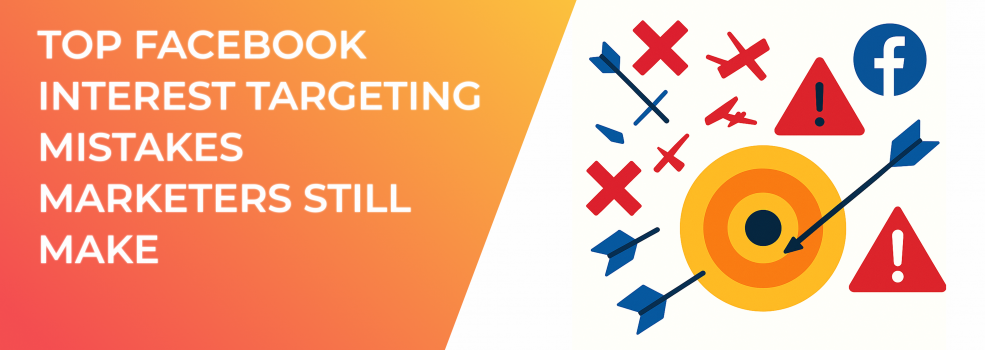Even in 2025, Meta Ads Manager is Facebook’s Swiss-army knife for paid social, yet most blades stay folded away. Facebook interest targeting can still put creative in front of the exact Facebook ad audience that cares, but only if you wield it with precision. After auditing more than 700 ad accounts in the past year at LeadEnforce, we keep rediscovering the same missteps. Below are the ten biggest Facebook ad targeting keywords pitfalls, why they flatten ROAS, and practical fixes for each one.
1. Setting “Interest Targeting” Once and Forgetting It
Here’s why letting interests go stale is expensive:
-
Ghost impressions – ads show to people who only loosely match your original criteria
-
Inflated CPMs – you pay premium rates for deprecated or junk categories
-
Data rot – the pixel learns from the wrong users and misguides future optimization
Action plan – keep interests fresh
-
Run a monthly interest audit.
-
Prune and replace dead interests with high-volume categories such as “digital nomadism,” “sustainable fashion,” or “AI art.”
-
Use a discovery tool like LeadEnforce Interest Explorer to surface real-time interests.
2. Choosing Only Broad, High-Volume Categories
Broad buckets look tempting, but they hide wildly different users:
-
Diluted messaging – one headline cannot resonate with everyone from metal guitarists to classical violin fans
-
Slow learning – Meta needs far more impressions to find patterns in a massive pool
Outdated interests quietly shrink reach and waste spend
Action plan – tighten the net
-
Layer niche Facebook ad targeting keywords (for example, “barbell training,” “HIIT at home,” “CrossFit Open”) with demographics and behaviors.
-
Apply geo filters. If you ship only in North America, exclude other regions.
-
Keep cold-audience size between 500 k and 3 M unless your monthly spend is seven figures.
3. Ignoring Audience Overlap
Overlapping ad sets quietly drain budget. The risks include:
-
Budget cannibalisation – your own ads bid against each other and raise CPMs
-
Creative fatigue – users see duplicate messages and start hiding your ads
Action plan – spot and solve overlap
-
In Ads Manager, select audiences and click Show Audience Overlap.
-
If overlap exceeds 25 %, consolidate or add exclusions.
-
Keep frequency under three for cold audiences and under six for warm ones.
4. Mixing Cold and Warm Audiences in One Ad Set
Merging strangers and fans confuses delivery and skews data. Two main problems arise:
-
Warm visitors inflate results and hide cold-audience costs.
-
Cold prospects stay stuck in the learning phase, limiting scale.
Action plan – separate the funnel
-
Create distinct campaigns:
-
Cold – interest stacks with education-heavy creatives
-
Warm – recent visitors, video viewers, or leads with urgency-driven creatives
-
-
Allocate separate budgets by funnel stage.
-
Track each funnel with its own dashboard.
5. Over-Relying on Lookalike Audiences
Lookalikes are powerful, but only when the seed is strong. Weak seeds create fuzzy twins and poor conversion intent.
Action plan – upgrade the seed
-
Collect at least 1 000 high-value events (purchases, renewals, webinar attendance).
-
Test 1 %, 3 %, and 5 % lookalikes separately; scale only if performance holds.
-
Refresh seeds every 30–60 days to stay current.
6. Neglecting Creative Relevance
Perfect targeting cannot fix lacklustre visuals. Low engagement triggers higher CPMs and faster fatigue.
Action plan – match creative to the audience
-
Mirror visuals to the interest (targeting “marathon training” means showing road runners, not generic gym shots).
-
Mention the interest directly in copy.
-
Add two new creatives every fortnight to hold quality scores.
7. Letting CPC Metrics Hide a Deeper Problem
A $0.40 CPC is meaningless if cost per purchase sits at $120 on a $40 product. Track post-click metrics first.
Download the benchmark table for CPM, CTR, and cost-per-purchase:
*Industry and niche will shift these ranges; use them as starting points.
8. Skipping Dedicated Tools
Relying on Ads Manager suggestions hands you the same interests every competitor sees, leading to higher competition and bland creative.
Action plan – widen your toolbox
-
Use LeadEnforce Interest Explorer or InterestExplorer.io for hidden categories, real-time volumes, and overlap scores.
-
Cross-check tool output with your campaigns to fill gaps.
-
Sync interests directly into Ads Manager to avoid manual errors.
9. Failing to Test and Scale Methodically
Changing everything at once scatters insights and resets the learning phase.
Action plan – test with discipline
-
Define a clear hypothesis.
-
Isolate one variable – the interest stack.
-
Let each test reach at least 50–100 link clicks or ten conversions.
-
Scale winners by 20 % every 48 hours or move them into Advantage+ Campaign Budget.
10. Forgetting to Exclude Recent Converters
Serving the same discount to new customers wastes money and annoys them.
Action plan – protect recent buyers
-
Set dynamic exclusions for 30–90 days; use longer windows for high-ticket items.
-
Sync your CRM so off-platform orders trigger exclusions.
-
After the exclusion window, switch to upsell or cross-sell creatives.
Final Thoughts
Winning with Facebook ad targeting keywords in 2025 is equal parts art and data science. Avoid these pitfalls, spend less time firefighting budgets, and more time crafting stories that resonate. LeadEnforce automates interest discovery, overlap checks, and lookalike hygiene so you can focus on strategy. Try it in your next campaign and watch your targeted Facebook ads reach high-intent audiences while competitors keep paying for empty clicks.

